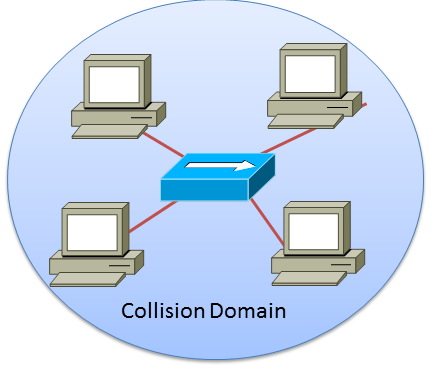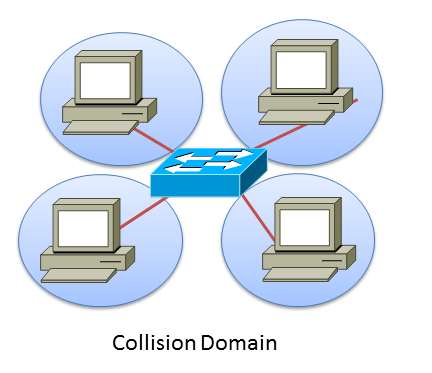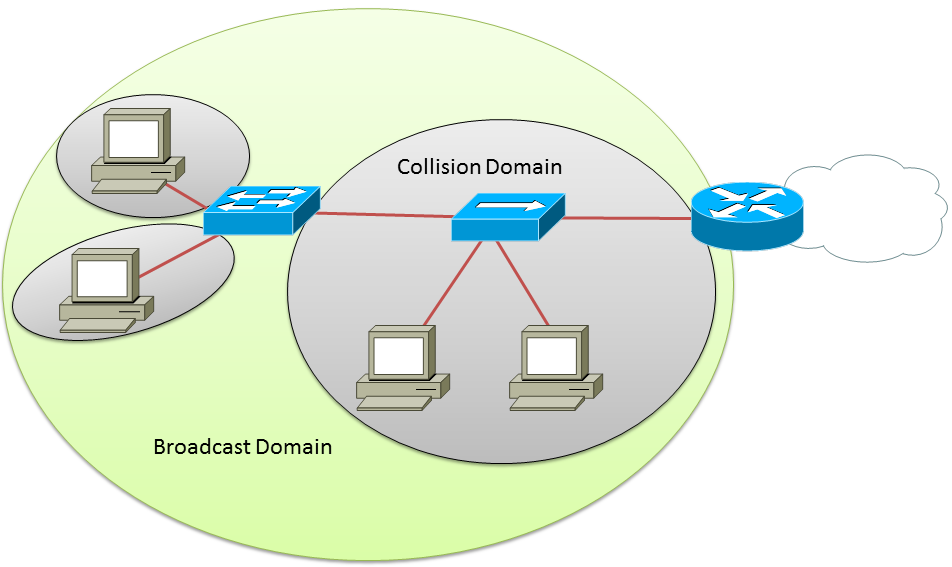Collision Domains vs Broadcast Domains
These different types of domains mean different things and when designing a LAN both of these domains can harm the performance of your network. If you are not aware of the difference between these two, this tutorial should help you out. If you have a small network at your home there is usually the router/modem that is connected via phone line or cable to the ISP that router/modem is then connected to a switch or they even have a switch built into the device. You connect a few cables turn on some devices and you now have an internet connection ready to go. In larger networks you have more choices that need to looked at. For example when to use a hub, a switch, or a router and how much money do you want to spend? Usually the more money spent you get more ports, performance increases and more features are added. These are all types of components that need to be thought of when designing a LAN. This tutorial is going to be focusing on two major things collision domains and broadcast domains.
The definition of a collision domain is a set of LAN devices whose frames could collide with one another. This happens with hubs, bridges, repeaters and wireless access points as only one device can send and receive. If more than one device tries sending or receiving, the information is lost and irrecoverable it will need to be resent. This can slow down network performance along with making it a security threat.
A hub is considered a layer one device of the OSI model; all it does is send frames out on all ports including the port in which the frame was received on. This causes a collision domain because only one device can send at the same time. This also shares the bandwidth between of all devices connected to that collision domain. These devices can inefficiently use that bandwidth because of the CSMA/CD and jamming signals that occur when a collision happens.

A switch uses layer two of the OSI model, so the switch uses MAC addresses to send frames to the correct device. Rather than sending it to all ports a switch only sends the frame out one port, if it has the MAC address in its MAC address table. If not the switch will send the frame on all ports except for the port in which the frame was received on. Switches provide separate collision domains on each port, this provides dedicated bandwidth to that device and allows simultaneous conversations between devices on different ports. Each port can be operated at full-duplex so the device can send and receive information at the same time.

A broadcast domain is like a collision domain, however the difference is these broadcast domains belong to a set of devices in the same layer two domain. These kind of blur together between a layer three broadcast message and a layer two broadcast message (FFFF:FFFF:FFFF). A layer two broadcast goes to every host in the same LAN/VLAN.
To make it little more fun there are two types of layer three broadcast messages :)
Limited/Local Broadcast - (255.255.255.255) is often used when the host really has no idea what network its on and waits for a DHCP server to respond back. As well as if a host needs to know the MAC address of a another host on the same LAN/VLAN. This broadcast goes to every host on the same LAN/VLAN and is the most common type of broadcast message.
Directed Broadcast - Is a directed IP packet whose destination is a valid broadcast address on the network that the host is not currently a part of. A router would forward this on to the correct network, however this is usually disabled by default. Example 192.168.1.255/24 Also keep in mind when you send a layer three broadcast you'll also send a layer two broadcast regardless of what type of layer three broadcast message is sent. This also works the other way, when you send a layer two broadcast message you'll also send a layer three broadcast message. (We work up and down the OSI model)
If devices are in the same IP network they will send and receive a broadcast messages and having a smaller broadcast domains can improve network performance as well as improve against security attacks. The more PCs and network devices connected to a single broadcast domain, the more broadcast messages you will have. A broadcast message goes to every PC that's on the LAN/VLAN. An example is when the router gets a packet from a different network and that packet is destined to host (192.168.1.124) it will send the packet if the router has the MAC address of 192.168.1.124. If the router does not have the MAC address of (192.168.1.124) in its MAC address table it will send an ARP (Limited/Local Broadcast) request before delivering the packet.
In this ARP request the router is basically saying who is 192.168.1.124? and tell me your MAC address. That broadcast message goes to every PC and network device in the broadcast domain. Each PC and network device that is in the 192.168.1.0/24 network has to look at the frame and then discard it if it's not 192.168.1.124. The PC that is 192.168.1.124 will respond back to the ARP request with an ARP reply. So a broadcast message can just be like a collision domain and affect network performance.

To find more information about collision domains and broadcast domains do a simple web search, you will find a lot of information. You can also go to the Cisco Learning Network to find that and more information about the networking world. I hope this tutorial was helpful.